Marulanda J.M. (ed.) Electronic Properties of Carbon Nanotubes
Подождите немного. Документ загружается.

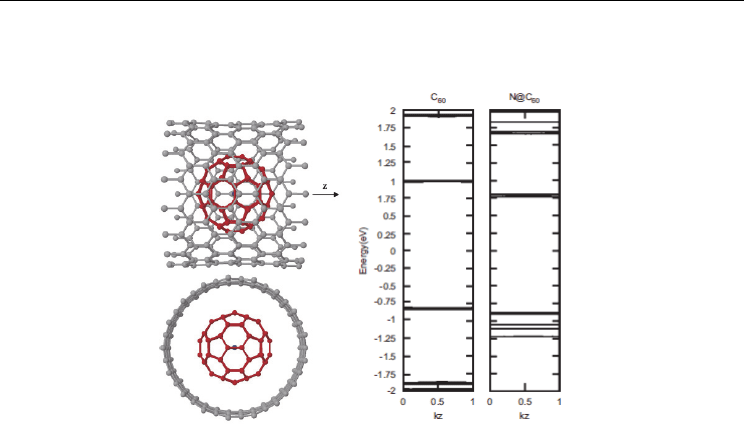
Electronic Structure and Magnetic Properties of N@C
60
-SWCNT
425
appreciable further contribution. These small changes to the band gap and Fermi level shifts
the support to the evidence that the nitrogen atom is well screened within the cage.
Fig. 2. The relaxed atomic coordinates of N@C
60
-SWCNT (17, 0). For clarity the carbon atoms
of the C
60
are shown in red and the nitrogen in blue. The band structures for infinite periodic
chains of C
60
and N@C
60
are shown. All the energies are given in units of E - E
F
for each
system. (Bailey et. al. (2007))
Design of spin labels inside for possible molecular spintronics, which contains of 1D spin
chains filling SWCNTs with magnetic endohedral fullerenes of N@C
60
and P@C
60
as spin
qubit have been proposed (Yang et. al. 2010). Jue reported a scheme to implement the two-
qubit gates between the nuclear spins of the encapsulated atoms in endohedral fullerenes
15
N@C
60
or
31
P@C
60
, within today’s magnetic resonance techniques (Jue et. al. 2007). The
electronic spin of the N and P ground state is 3/2, while the nuclear spin is either 1/2 (
15
N,
31
P) or 1(
14
N). The electronic structure at highest occupied molecular orbital (HOMO),
lowest unoccupied molecular orbital (LUMO), the magnetic and optical properties of
N@C
60
-SWCNT have been characterized on the basis of magnetic techniques of NMR, ESR
and electronic nuclear double resonance (ENDOR) (Benjamin, et. al. 2006) using ab-nitio
quantum calculation. The relaxation properties of the
14
N nucleus in N@C
60
were
determined using techniques related to Davies ENDOR which have been proposed for
measuring T
1
and T
2
. In order to demonstrate the effectiveness of the bang-bang decoupling
scheme in N@C
60
, a strong environmental interaction has been simulated by applying a
strong RF field to drive Rabi oscillations in the nuclear spin; this strong RF field was then
decoupled by applying fast phase ‘kicks’ using the π phase gate (Morton et. al. (2006)).
Figure 3 shows Bang-bang control of fullerene qubits by ultrafast phase gates. Morton
discussed the benefits of a coupled electron spin to the nuclear spin qubit and demonstrated
the ideas using the
14
N nuclear spin in the N@C
60
molecule. In addition to providing a
resource for nuclear spin polarization and detection, the electron spin can be exploited to
perform ultrafast nuclear spin phase gates, which can in turn be used to dynamically bang-
bang decouple the nuclear spin from unwanted interactions. Figure 4 shows arbitrary
nuclear phase gates are implemented by driving two electron spin transitions
simultaneously (Morton (2005)). The path of the electron magnetization vector was driven
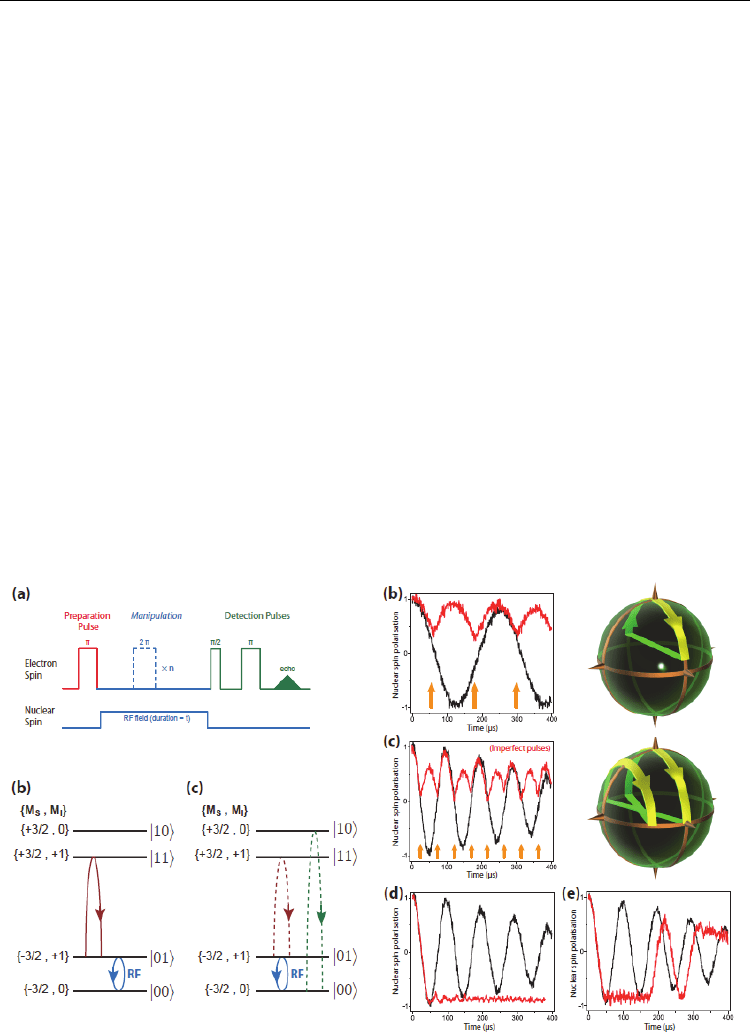
Electronic Properties of Carbon Nanotubes
426
by a microwave field. The corresponding z-magnetizations are displayed as shown in Fig. 4
(a). One transition is driven resonantly, and one strongly detuned. On each cycle, the phase
accumulated is proportional to the area enclosed by the path. Both transitions must undergo
an integer number of complete cycles to ensure the populations remain unchanged. As
shown in Fig. 4 (b), both transitions were detuned by equal and opposite amounts, the
population evolution for each is the same, whilst the phase accumulated is of opposite sign.
Hence, the relative phase shift can be tuned by controlling the microwave pulse power.
The effect of the non-nearest neighbor couplings has been investigated (Yang et. al. (2010)).
Figure 5 show transitions of a single qubit in the presence of couplings to other qubit as a
function of the chain length.
The uppermost spectrum corresponds to the case of nearest
neighbors only [trace (a)]. If non-nearest neighbors are added [see trace (b)], each resonance
line splits into seven lines separated by D
nn
/8, where D
nn
is the coupling between nearest
neighbors. The weight of the lines (1:2:3:4:3:2:1) is given by the number of states of the next-
nearest neighbors. Adding a third pair of qubits causes an additional splitting of each line
into a (1:2:3:4:3:2:1) multiplet, with line separation D
nn
/64. With the resolution of the figure
[see trace (c)], this appears as a line broadening. The ESR frequency on transitions of a single
qubit was appeared in the presence of couplings to other qubit under nearest neighbor.
Especially, electronic spin qubits on five molecules of N@C
60
in a magnetic field gradient has
been simulated. The magnetic parameters of principle g-tensor, hyperfine coupling constant
of nitrogen atom and chemical shift of
13
C in
14
N@C
60
within SWCNT for chiral index (n, m)
are important to control a quantum qubit-gate of 1D spin in the NMR quantum-computer.
In the present work, geometrical effect of diameter and chiral index on the electronic
structure, magnetic and optical properties of N@C
60
-SWCNT have been investigated on the
basis of experimental results using ab-initio density functional theory.
Fig. 3. Bang-bang control of fullerene qubits by ultrafast phase gates. (Morton et. al. (2006))
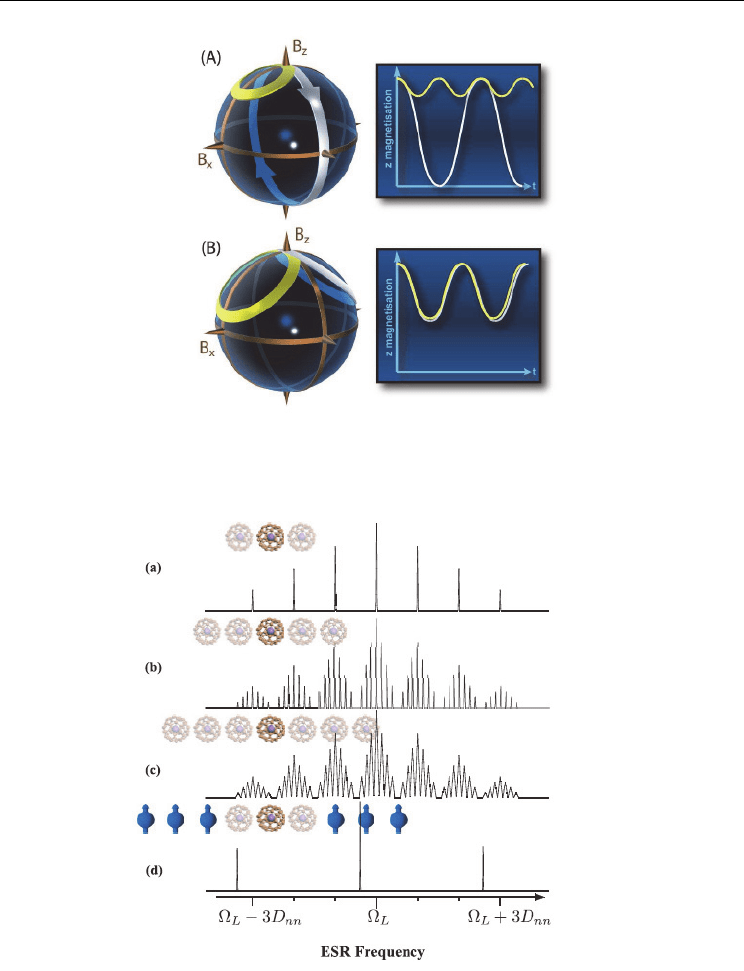
Electronic Structure and Magnetic Properties of N@C
60
-SWCNT
427
Fig. 4. Arbitrary nuclear phase gates are implemented by driving two electron spin
transitions simultaneously (Morton (2005))
Fig. 5. Transitions of a single qubit in the presence of couplings to other qubits as a function
of the chain length. (a) Nearest neighbors only. (b) Nearest neighbors and next-nearest
neighbors. (c) Three qubits on each side. (d) Infinite chain, where all but the nearest
neighbors are polarized. (Yang et. al. (2010))

Electronic Properties of Carbon Nanotubes
428
2. Quantum chemical calculation
The molecular structures were assembled by CS ChemDraw, CS Chem3D (Cambridge Soft)
and Nanotube Modeler (JCrystal Soft). Molecular orbital calculations were carried out by
molecular mechanics calculations (MM2) and semi-empirical molecular orbital calculations
(Hamiltonian: Parameterized Model Revision 3: PM3). In addition, the isolated molecular
structures were optimized by ab-initio quantum calculation using unrestricted Hartree–Fock
(UHF) and DFT using UB3LYP with hybrid function LANL2DZ and STO-3G*, 3-31G* and 6-
31G* as basis set (Gaussian 03 Inc.). The electronic structure at HOMO, LUMO, LUMO+1
and the HOMO-LUMO band gap (E
g
) were calculated. Nitrogen atomic charges of
14
N@C
60
within SWCNT were estimated using Mulliken population analysis. Wavelength and the
exited transition state were calculated by time-dependence of DFT (TD-DFT) with hybrid
function UB3LYP and 3-31G* as basis set. Continuously, chemical shift of
13
C (δ), principle
g-tensor (g
xx
, g
yy
, g
zz
) and principle A-tensor (A
xx
, A
yy
, A
zz
) in hyperfine coupling constant
(hfc) of nitrogen atom were calculated by DFT using NMR/GIAO with hybrid function
UB3LYP and 3-31G* as basis set.
3. Results and discussion
3.1 Electronic structure of N@C
60
-SWCNT
Electronic structure of molecular orbital at HOMO, LUMO, next LUMO+1 and energy levels
of N@C
60
-SWCNT-armchair have been investigated by DFT with hybrid function UB3LYP
using 6-31G* as basis set. Molecular orbitals and energy levels of
14
N@C
60
-SWCNT armchair
(13, 13), N@C
60
and SWCNT are shown in Fig. 6. The molecular orbital of N@C
60
-SWCNT-
zigzag (13, 13) was delocalized on -electrons at a long axis of SWCNT surface interacted
with -electrons on the N@C
60
cage surface as hybrid orbital interaction. The energy level
between HOMO-LUMO was smaller than that of original SWCNT. This behavior was due to
a mixture of binding interaction with spin distribution.
Molecular orbital of
14
N@C
60
-SWCNT (9, 9) and SWCNT at (a) HOMO, (b) LUMO, (c)
LUMO+1 are shown in Fig. 7. The molecular orbital of N@C
60
-SWCNT-zigzag (9, 9) was
delocalized on -electrons at a long axis of SWCNT surface interacted with -electrons on
the N@C
60
cage surface as hybrid orbital interaction. The energy gap of N@C
60
-SWCNT
between HOMO and LUMO was estimated to be 1.16 eV, which was smaller than that of
original SWCNT (9, 9) to be 1.24 eV, due to a mixture of binding interaction. Mulliken
atomic charge of N in
14
N@C
60
within SWCNT was 3.8 x 10
-5
e. This result indicates a slight
charge transfer from nitrogen atom to C
60
cage within SWCNT. This supports the assertion
that the nitrogen is well screened within the C
60
cage.
Electronic structures of N@C
60
-SWCNT-zigzag (14, 0) at (a) HOMO, (b) LUMO and (c)
charge distribution are shown in Fig. 8. The molecular orbital were well distributed around
the SWCNT interacted with C
60
surface cage. Energy gap between HOMO and LUMO was
estimated to be 0.87 eV, which indicates semi-conductive behavior. There existed a wide
charge distribution on the inner surface of SWCNT, which had -electron interaction with
hybrid orbital on the C
60
surface cage.
Figure 9 show molecular orbital of (
14
N@C
60
)
2
-SWCNT-armchair (9, 9) at (a) HOMO and (b)
LUMO, calculated by DFT/UB3LYP/STO-3G*. In both cases at HOMO and LUMO,
molecular orbital of (
14
N@C
60
)
2
-SWCNT (9, 9) formed a circle ring to distribute on the
SWCNT surface. The band gap between HOMO and LUMO was estimated to be 3.72 eV,
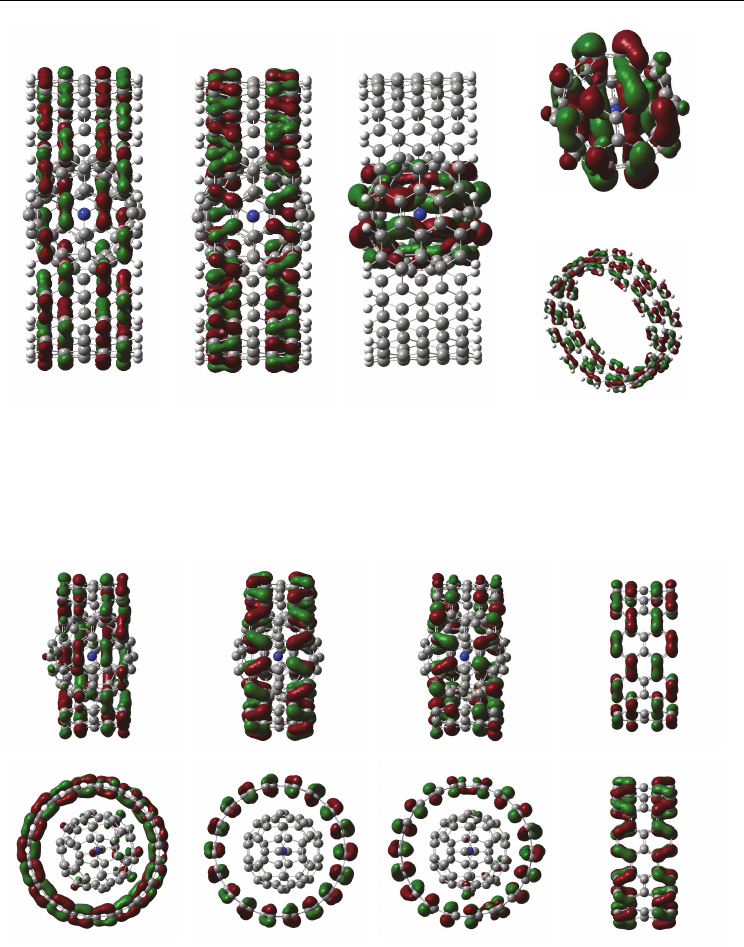
Electronic Structure and Magnetic Properties of N@C
60
-SWCNT
429
(a) HOMO (b) LUMO (c) LUMO+1
-2.02 eV -1.25 eV -0.71 eV
14
N@C
60
LUMO -3.57 eV
SWCNT (13, 13) HOMO -4.06 eV
Eg=1.20 eV
Eg = 0.76 eV
Fig. 6. Molecular orbitals and energy levels of
14
N@C
60
-SWCNT armchair (13, 13), N@C
60
and SWCNT (Suzuki, el. al. (2010))
(a) HOMO (b) LUMO (c) LUMO+1
-4.05 eV -2.89 eV -2.26 eV
(a) HOMO -4.08 eV
(b) LUMO -2.84 eV
Mulliken N atomic charge 0.000038
N@C
60
-SWCNT (9, 9) SWCNT (9, 9)
Fig. 7. Molecular orbital of
14
N@C
60
-SWCNT (9, 9) and SWCNT at (a) HOMO, (b) LUMO, (c)
LUMO+1 and energy levels (Suzuki et. al. (2010)).
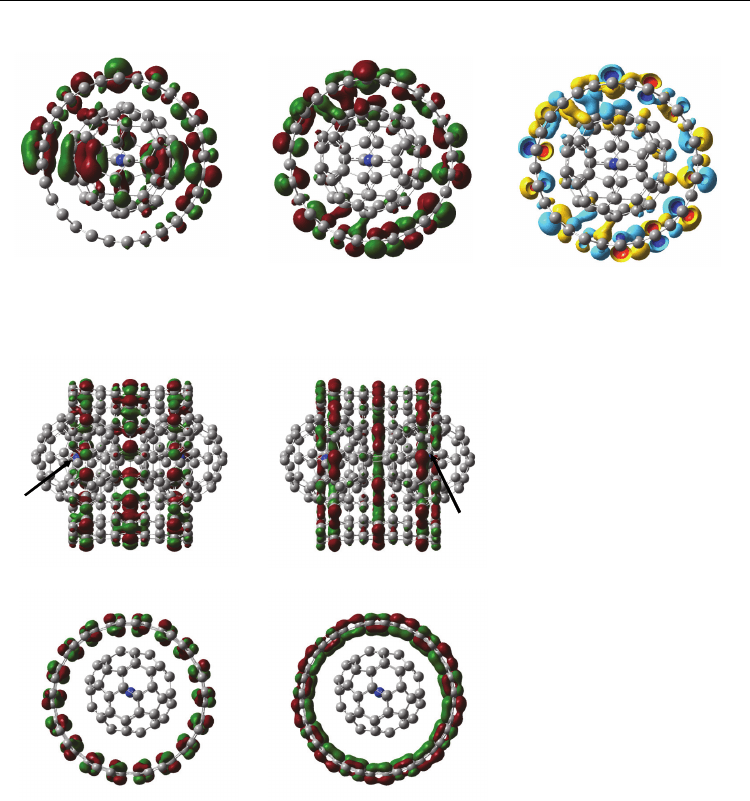
Electronic Properties of Carbon Nanotubes
430
(a) HOMO = -5.23 eV (b) LUMO = -4.36 eV
(c) Charge distribution
Fig. 8. Molecular orbital of
14
N@C
60
-SWCNT-zigzag (14, 0) at (a) HOMO, (b) LUMO and (c)
charge distribution. (Suzuki et. al. (2010))
LUMO+1 = 2.21 eV
LUMO = 0.71 eV
HOMO = -3.01 eV
HOMO-1 = -4.39 eV
E
g
= 3.72 eV
Mulliken atomic charge / N
N
1
=2.998, N
2
=2.998
N
1
N
2
(a) HOMO (b) LUMO
Fig. 9. Electronic structures of (
14
N@C
60
)
2
-SWCNT-armchair (9, 9) at (a) HOMO and (b)
LUMO. (Suzuki et. al. (2010))
which was larger than 1.72 eV, 3.06 eV and 2.11 eV of SWCNT (9, 9), N@C
60
and (N@C
60
)
2
.
Mulliken atomic charge of nitrogen atom in (
14
N@C
60
)
2
-SWCNT (9, 9) was estimated to be
2.998e. This positive charge indicates a considerable charge transfer from nitrogen atom to
C
60
cage within SWCNT.
3.2 Electronic structure of N@C
60
Electronic structure of N@C
60
(S=3/2, I=1) at HOMO, LUMO and energy levels are shown in
Fig. 10. The molecular orbital was considerably distributed on the C
60
surface cage. Mulliken
N atom charge was 0.21e, which indicates charge transfer from nitrogen atomic to the C
60
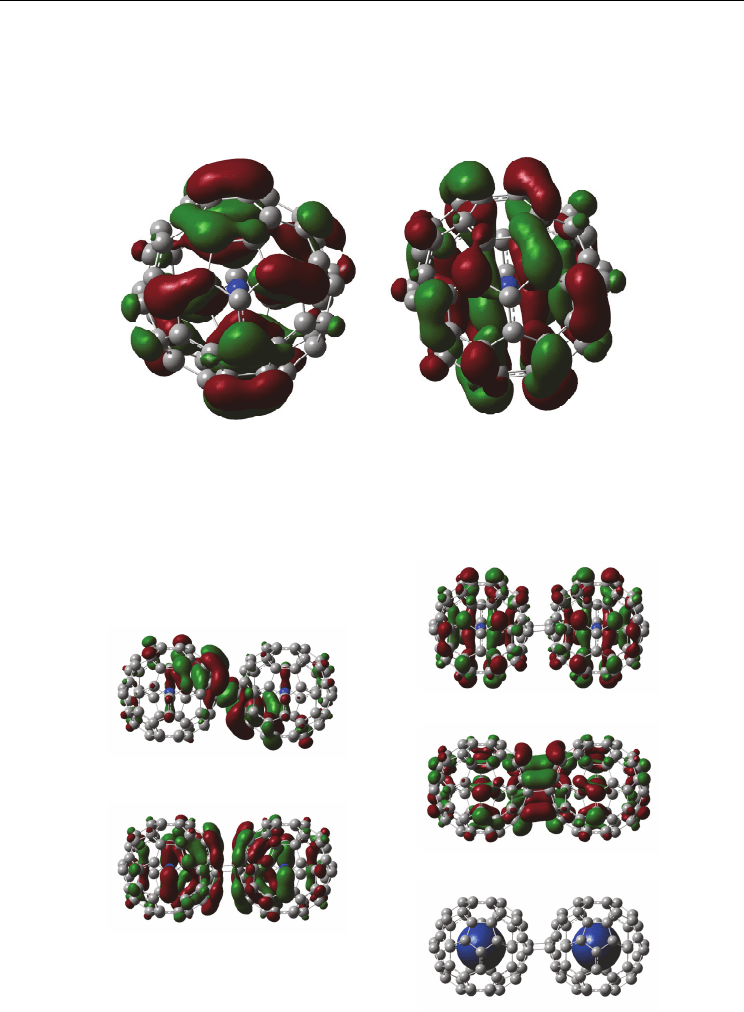
Electronic Structure and Magnetic Properties of N@C
60
-SWCNT
431
surface cage. The energy gap between HOMO and LUMO was estimated to be 3.0 eV, which
made agreement with the experimental energy gap of N@C
60
(2.7 eV) adsorbed on Cu (887)
surface. The molecular structure with the energy levels have been investigated by scanning
tunneling microcopy/spectroscopy (STM/STS) and near-edge x-ray absorption fine
structure (NEXAFS) spectrum (Schiller, et. al. 2006).
Mulliken atomic charge 0.211512
HOMO
-6.60 eV
LUMO
-3.57 eV
(a) HOMO (b) LUMO
E
g
= 3.0 eV
Fig. 10. Electronic structure and molecular orbital of N@C
60
at (a) HOMO (a) and (b) LUMO
(Suzuki et. al. (2010))
(a) HOMO -5.95 eV
(b) HOMO-1 -6.12 eV
(c) LUMO+1 -3.59 eV
(d) LUMO -3.84 eV
(e) Spin density
Band gap (E
g
) = 2.11 eV cf. N@C
60
Eg = 3.0 eV
Mulliken atomic charge,
N
1
and N
2
= 0.004299, 0.004381
cf. N@C
60
N = -0.004522
N
1
N
2
Fig. 11. Electronic structures of (N@C
60
)
2
at (a) HOMO, (b) HOMO-1, (c) LUMO+1, (d)
LUMO and (e) spin density. (Suzuki et. al. (2010))
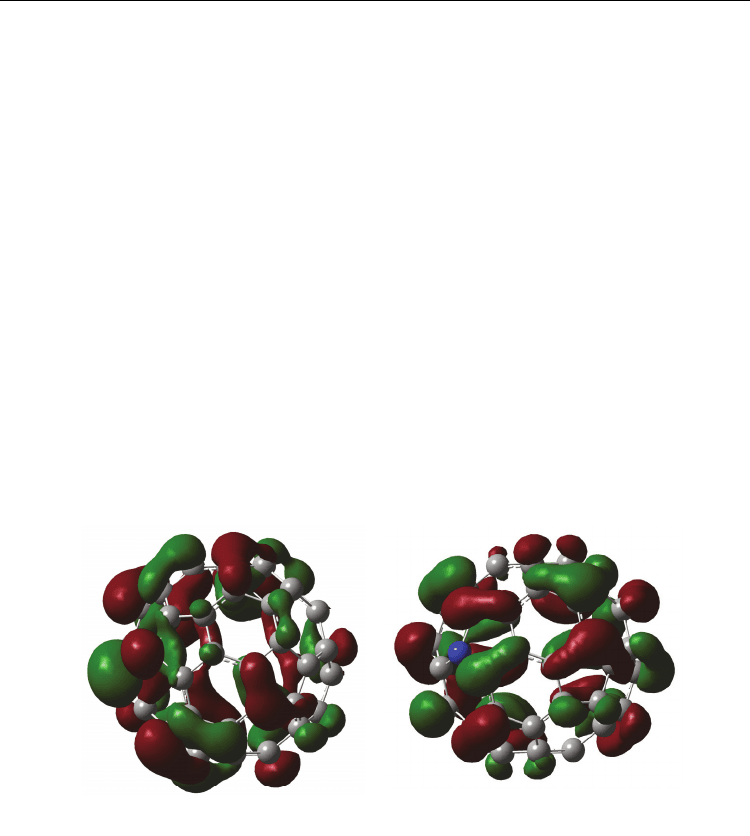
Electronic Properties of Carbon Nanotubes
432
Electronic structures of (
14
N@C
60
)
2
as dimmer at (a) HOMO, (b) HOMO-1, (c) LUMO+1, (d)
LUMO, (e) spin density and Mulliken atomic charge of N
1
and N
2
are shown in Fig. 11. The
molecular orbital of the (N@C
60
)
2
at HOMO and LUMO were partial to distribute between
the C
60
surface cages. The molecular orbital was interacted with each other on π electron of
hybrid orbital. The energy gaps between HOMO and LUMO were estimated to be 2.11 eV,
which was smaller than that of N@C
60
. The dimerization was stable. The molecular orbital at
HOMO-1 and LUMO+1 were well distributed around the C
60
cage surfaces. The molecular
orbital was anti-interacted with each other, due to anti-bonding behavior of isolated
molecular orbital of N@C
60
. Mulliken atomic charge of N
1
and N
2
in (N@C
60
)
2
were at
0.004299 e and 0.004381 e. The slight values of positive charge were due to slight charge
transfer from N atoms to the surface cage of C
60
.
3.3 Electronic structure of C
60
N
Electronic structure of C
59
N (S=1/2, I=1) at HOMO and LUMO are shown in Fig. 12. The
molecular orbital were impartially distributed on the C
60
cage surface. Mulliken N atomic
charge was -0.6e. The negative value indicates considerable charge transfer from C
60
cage to
nitrogen atom. The energy gap between HOMO and LUMO was calculated to be 1.29 eV,
which made agreement with the experimental result of (C
59
N)
2
at 1.1 eV by C K NEXAFS
spectrum (Schulte, et. al. 2007). The dimerization of (C
59
N)
2
was stable as compared with
isolation of C
59
N.
Mulliken N atomic charge -0.6058
HOMO
-4.58 eV
LUMO
-3.29 eV
(a) HOMO (b) LUMO
E
g
= 1.29 eV
Fig. 12. Electronic structure and molecular orbital of C
59
N at (a) HOMO and (b) LUMO.
(Suzuki et. al. (2010))
The single replacement in C
59N keeps the bond lengths close to the C60 values (1.40 and 1.45
Å). The dimerization has strong effects as shown in Fig. 13. The charge redistributes itself to
weaken the intramolecular bonds of the tetra-coordinated C´ and to strengthen both the N-C
bonds on the pentagon and the “double” bonds in the hexagons containing C´-N. This bond
turns out to be a relatively weak one, as the electron density distribution emphasizes. In
combination with the weak intermolecular C´-C´ bonding, this results in an electronic
environment for C´ remarkably different from that of a typical sp
3 atom. This fact should
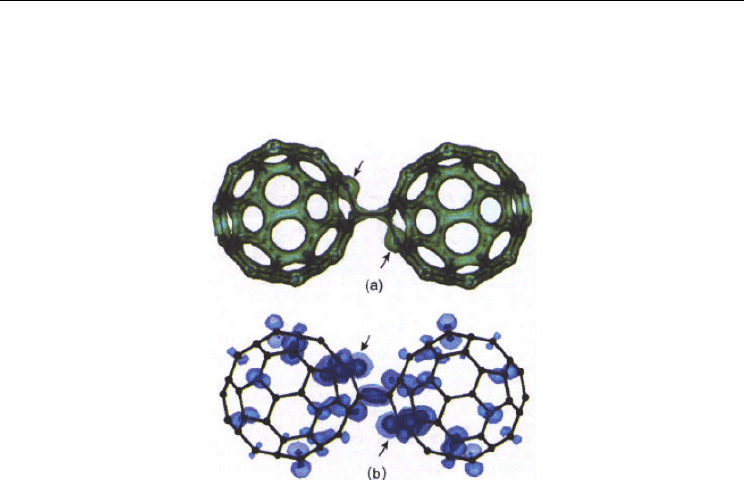
Electronic Structure and Magnetic Properties of N@C
60
-SWCNT
433
account for the missing NMR signal in the sp3 region. Accurate calculations of the carbon
chemical shifts would be highly desirable. Their calculations predict a very similar structure
for the latter (anti-conformation), apart from the much elongated intermolecular distance
(1.675Å). The anti-conformation has been determined also by less sophisticated calculations
.
Fig. 13. For (C
59
N)
2
: Isodensity hypersurfaces of (a) the electron density and (b) the HOMO.
Values (in au) are 0.2 (a); 0.002 (dark) and 0.0005 (light) (b). (
Andreoni et. al. (1996))
3.4 Electronic structure of (C
60
)
3
as trimmer
Electronic structure of the C
2h
symmetry trimmer, (C
60
)
3
based on the P4 peanut has been
studied (Beu 2006). The HOMO and LUMO energies obtained with the PBE (HCTH)
functional are respectively E
HOMO
=-0.175 (-0.179) a.u. and E
LUMO
=-0.171 (-0.173) a.u. The
distribution of the Mulliken charges in the two waist regions are similar to those of the
dimmer (between -0.030 e and +0.056 e for the PBE functional). Figure 14 shows geometrical
structure and HOMO-orbital (isovalue 0.01) of the C
2h
symmetry C
60
trimer, (C
60
)
3
based on
the P4 peanut. The HOMO-orbital qualitatively showed the same behavior, bridging the
cages. A transverse nodal plane through the middle of the central cage seems to limit the
delocalization of the electrons. Anyway, for all methods the HOMO-LUMO gap of the
trimmer was significantly reduced as compared to the dimmer, (C
60
)
3
, continuing the
monotonous decrease with respect to the C
60
monomer.
3.5 Geometrical effect of N@C
60
-SWCNT, SWCNT, N@C
60
and C
59
N on electronic
structure
Geometrical effect of N@C
60
-SWCNT, SWCNT, N@C
60
and C
59
N on the electronic structure
has been investigated by DFT using UB3LYP. Table 2 lists comparison between N@C
60
-
SWCNT, (N@C
60
)
2
-SWCNT, SWCNT, (N@C
60
)
2
, N@C
60
and C
59
N on energy levels at
HOMO, LUMO and band gap (E
g
). The energy levels of N@C
60
-SWCNT were affected by
diameter and chiral index. The energy levels of N@C
60
-SWCNT compared with SWCNT had
effected with increasing diameters. Especially, the energy gap of N@C
60
-SWCNT was
smaller than those of SWCNT, N@C
60
and C
59
N. This behavior would be originated in
narrowing energy gap based on molecular interaction between N@C
60
and SWCNT. These
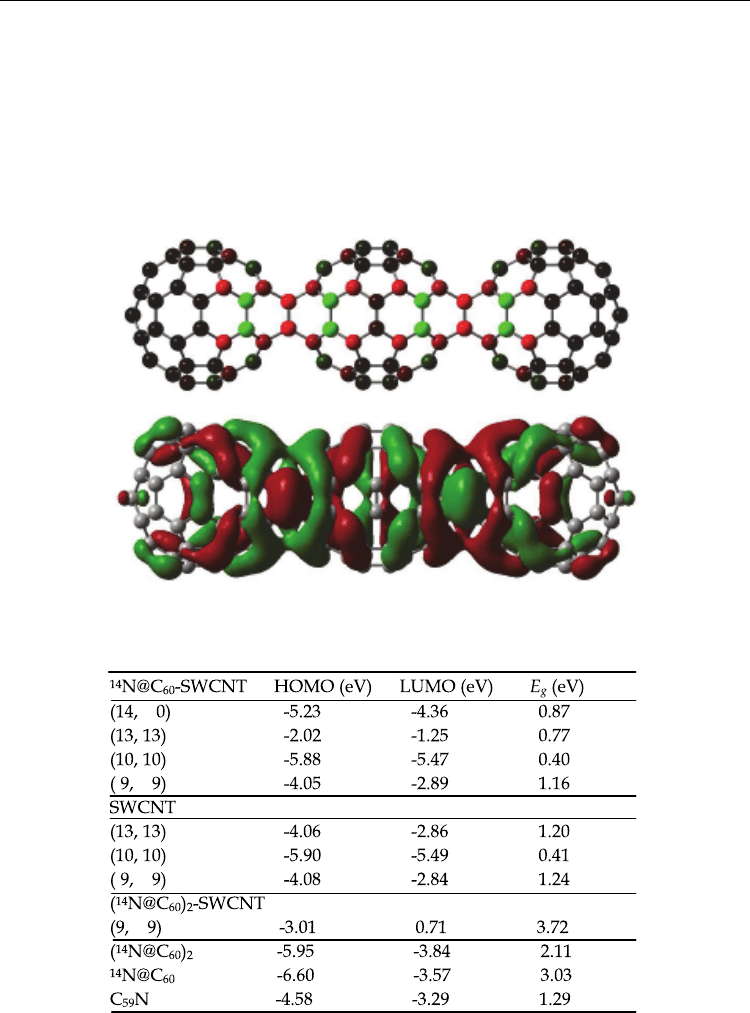
Electronic Properties of Carbon Nanotubes
434
behaviors of
14
N@C
60
-SWCNT were considerably closed to those in density of state (DOS),
which calculated with a tight binding model for SWCNT armchair. Electronic density of states
(DOS) calculated with a tight binding model for SWCNT armchair (8, 8), (9, 9), (10, 10), and
(11, 11) are shown in Fig. 16. The HOMO-LUMO gaps of SWCNT (n, n) for n = 9-13 as metal
were inverse proportion to the diameters (Rao, et al. 1997). The energy gap of (N@C
60
)
2
-
SWCNT (9, 9) was extend to be 3.72 eV as compared with that of N@C
60
-SWCNT (9. 9), due to
instable dimmer within SWCNT. As reference, the energy gap of dimmer, (
14
N@C
60
)
2
was
estimated to be 2.11 eV, which was smaller than that of
14
N@C
60
, due the stable formation.
Fig. 14. Geometrical structure and HOMO-orbital (isovalue 0.01) of the C
2h
symmetry C
60
trimer, (C
60
)
3
based on the P4 peanut. (Rue (2006))
Table 2. Comparison of N@C
60
-SWCNT, (N@C
60
-SWCNT)
2
, SWCT, (N@C
60
)
2
, N@C
60
, and
C
59
N on energy levels (Suzuki, et. al. (2010))
